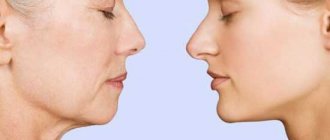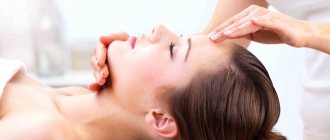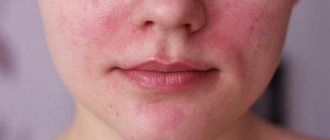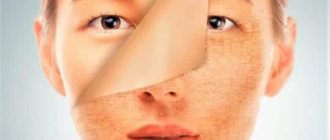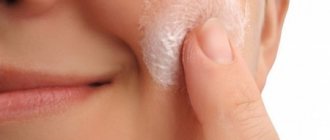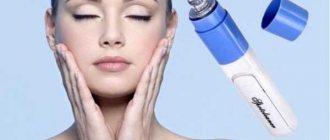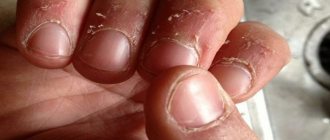If you do not start taking care of dry facial skin in a timely manner, premature wrinkles will quickly appear and early wilting will occur. Lack of moisture in the skin can occur due to improper care or exposure to external factors. Peeling, redness and itching of the skin occurs. To eliminate discomfort, you need to contact a dermatologist or cosmetologist for recommendations. To eliminate it, you can additionally use folk remedies.
- Cleansing
- Dairy formulations
What is the difference between dry skin and dehydrated skin?
Dryness is a constant characteristic of the skin, which has genetic causes and a weak lipid barrier. Such skin does not retain moisture well. Taking care of it requires regular care using moisturizing and nourishing products.
Dehydration is a specific condition of the epidermis of any type, which is caused by a lack of moisture. In this case, the skin also experiences dryness. Lipid metabolism is disturbed, a feeling of tightness and peeling is characteristic.
What affects the condition of the skin?
The reasons for dehydration of the epidermis are as follows:
- avitaminosis;
- poor nutrition;
- dysfunction of the sebaceous glands;
- poorly selected care products;
- improper care;
- heredity;
- diseases of the body;
- exposure to unfavorable external conditions.
The main reason for this condition is age-related changes and individual characteristics of the body. Dehydrated skin does not perform its functions sufficiently; due to the lack of moisture, the production of elastin and collagen decreases.
How to determine your skin type?
Experts distinguish 4 types of skin:
- normal;
- fatty;
- dry;
- combined.
Caring for each of them has its own characteristics. A test to determine dry facial skin type can be carried out as follows:
- Wash your face.
- After 2 hours, lie down and cover your face with a paper napkin.
- Press it tightly with your palms.
- Remove after 10 minutes.
If there are no oily spots, then the skin is dry. Only a cosmetologist or dermatologist will carry out an accurate diagnosis.
The type of skin can change due to changes in hormonal levels, climatic conditions, internal processes in the body and the influence of other factors.
Signs of dehydration
Dry facial skin quickly loses moisture because the top layer (epidermis) is not protected by an oily coating due to weak sebum secretion. The symptoms of this condition are as follows:
- pale color;
- peeling;
- loss of elasticity;
- itching;
- narrowed pores;
- tightness;
- allergic reaction to ultraviolet rays;
- lack of shine;
- rough appearance;
- formation of wrinkles;
- early aging.
You can confirm your dehydration status with a simple test. If you smile very widely, you will immediately notice small wrinkles in areas with active facial expressions. They disappear after applying the cream. Peeling and roughness of the epidermis are manifestations of extreme dehydration.
The main sign of dry skin is peeling, which is accompanied by redness, itching, and irritation. A combination of symptoms may indicate the cause of their occurrence:
- Dryness with flaking. It is observed not only with dehydration, but also with long-term use of medications, food poisoning, and the negative impact of external natural factors.
- Dryness with redness. Appears when exposed to aggressive cosmetics or seasonal factors. It lasts for several days, but as the skin regenerates, the spots disappear. Persistent redness is caused by diseases. The problem must be eliminated, otherwise a complication will appear in the form of peeling.
- Dryness with redness and irritation. Develops with skin diseases and disorders of internal organs, as well as with allergies. The cause of irritation may be hormonal imbalance during menopause or pregnancy, poorly chosen care products, or food harmful to the body.
- Severe dryness and itching. Most often associated with a reaction to weather factors, visiting a sauna, solarium or bathhouse. Itching can be caused by taking medications, the components of which the body rejects, as well as vitamin complexes. It also appears in skin diseases.
Oily skin
Oily skin - shiny, rough, sallow in color. The sebaceous glands produce more oil than necessary, making facial skin oily with enlarged pores. This type of skin often has acne and is prone to pimples. Oily skin needs to be cleansed more often than other skin types. It retains more particles of dust and makeup, which clog the pores, leading to the formation of acne. If you have oily skin, you should wash your face three times a day with soap and water.
In the evening, remove any remaining makeup with a cleansing cream. Use mild tonic lotions that increase blood circulation and improve skin texture. It is not necessary to moisturize oily skin, but you can use a non-greasy moisturizer during the day.
Secrets of caring for dry skin at home
Prevention of dry epidermis should begin in advance, even if discomfort is not felt.
General principles of facial skin care include:
- cleansing;
- hydration;
- nutrition;
- toning;
- protection.
Cleansing
You should not use regular toilet soap; it dries out the epidermis. It is recommended to purchase a moisturizing or delicate foam.
Kefir or yogurt is suitable for peeling, as it also restores the lipid barrier. You need to cleanse your face 2 times during the day.
Oil-based products are used to remove makeup. In the morning, after washing with warm boiled water with the addition of baking soda, you need to apply nourishing milk. You can use ready-made micellar water, tonic, or a self-prepared decoction of St. John's wort, sage, and mint.
You cannot wash your face with hot water, as there is a risk of drying out the epidermis even more.
Cosmetics intended for the care of dry skin should not contain alcohol.
Hydration
You need to purchase ready-made cream with the appropriate labeling. A daytime cosmetic product should have a light texture, a nighttime one should have a thick texture.
From available means, sour cream, honey, apple or tomato puree will help restore the normal condition of the skin.
Nutrition
A quality cream should contain:
- amino acids;
- lactic acid;
- triglycerides;
- fatty acid.
To normalize the functioning of the sebaceous glands, a fortified and biologically active product is required. Vitamin A should be present in decorative cosmetics.
Toning
Tonics based on oils, vitamins and moisturizers are suitable for this purpose. They need to be applied twice a day.
In the morning, wipe the skin with cosmetic ice, prepared independently from a decoction of chamomile, rowan leaves and mint.
Protection
The dry type of epidermis does not tolerate low temperatures. Before leaving the house, you need to lubricate your face with cream, otherwise the skin will become inflamed and peel off. In winter, you only need to wash your face in the morning and before bed with warm water, adding a few drops of glycerin. In summer, the face should be protected from ultraviolet rays.
You can use a natural monocomponent moisturizing mask:
- cottage cheese;
- apple;
- egg
It is necessary to remove masks only with warm boiled water.
Normal skin
Normal skin looks clean (no spots, rashes or flaking), it is velvety, smooth and elastic, without large pores or dead cells.
Sometimes pustules may appear before menstruation. During this period, increased formation of hormones occurs, which increases the activity of the sebaceous glands, but for people with normal skin, pustules and pimples are not a problem. In the morning, wash your face with plain water, soap, bran or rose water. In the evening, remove makeup with a cleansing cream and apply a toning cream to soften the skin. Use a moisturizer underneath the powder.
Care products
To restore the biobalance of moisture, you can use the following moisturizers:
- cream;
- lotion;
- mask;
- oil.
The cream always contains natural moisturizers and skin nourishing ingredients. Cucumber, raspberry extract, and aloe vera will restore the lack of minerals and vitamins.
Lotion is necessary for cleansing and moisturizing. It should always include cucumber or citrus juice.
Masks can moisturize the epidermis in the same way as a cream. It is recommended to include plant extracts necessary for deep nutrition and moisturizing of the skin.
Essential oils of geranium, cinnamon, orange and lemon moisturize the dermis at the cellular level and help fight discomfort.
Peeling as a sign of dermatological diseases
The appearance of flaking skin flakes can be a sign of many dermatological diseases. In this case, the use of cosmetics and procedures will not be enough; a complex effect with careful individual selection of drugs is required. Since it is impossible to get rid of peeling on the face without affecting the main links of pathogenesis, it is necessary to consult a doctor as early as possible for examination and establishment of an accurate diagnosis. And self-medication can contribute to the complicated course of the disease.
In dermatological diseases, peeling in most cases is a secondary symptom. It appears only after some time against the background of papules, vesicles or nodular changes and is a sign of the natural development of pathological foci. The nature of the resulting scales depends on the etiology of the disease and the presence of impurities of sebum, lymph or serous-purulent discharge.
Most of these diseases are acquired. Only ichthyoses are hereditary conditions, leading to characteristic damage to the entire skin even before the birth of the child. In atopic dermatitis, there is also a congenital predisposition associated with impaired functioning of the immune system.
Some diseases that lead to peeling
Psoriasis
It is a chronic non-infectious disease with a rather complex pathogenesis. It results in the appearance of red, itchy lesions on the skin that tend to spread and coalesce. Psoriatic lesions on the face are an uncommon occurrence; in this case, they speak of an atypical form of the disease. After all, the favorite places for psoriasis rashes are the extensor surfaces of the limbs and the torso.
Psoriasis rashes are predominantly localized around the eyes, eyebrows and nasolabial folds. But there is also a special form of the disease - seborrheic psoriasis. In this case, plaques form in places with increased formation of sebum, mainly at the border of the scalp, naso-buccal folds and behind-the-ear areas. This disease is differentiated primarily from seborrhea (seborrheic dermatitis).
Seborrhea
Associated with dysfunction of the sebaceous glands. In this case, pathological lesions can appear on the face, behind the ears and on the scalp. There is a dependence of the severity of the disease on hormonal status, which is why seborrhea is more often detected in men and adolescents. In women, its debut may be due to a decrease in estrogen levels with an increase in the concentration of androgen-like substances.
There are 2 forms of seborrhea: dry and oily. Irritation, dryness, itching and severe flaking are the main symptoms of dry seborrheic dermatitis. In this case, red-pink itchy lesions appear in the eyebrows and cheeks, they can also affect the eyelash growth area. The changes are symmetrical and often involve the scalp.
Systemic lupus erythematosus
SLE is a disease with an autoimmune mechanism affecting the skin of the face. The rashes that appear in this case are localized mainly in the nasobuccal areas, leading to the formation of a characteristic “butterfly”. Systemic lupus erythematosus is characterized by erythema, infiltration and follicular hyperkeratosis of the skin. After some time, they are replaced by cicatricial atrophy, which begins to form from the middle of the lesion.
Patients with a significant history of the disease have all possible types of skin changes on their face. In the center of a long-existing lupus lesion there is an area of smooth, smooth, thin, atrophic white skin. It is surrounded by an infiltration ridge, covered with dry, tight-fitting scales with spiny outgrowths on the underside. And on the periphery there is a rim of hyperemia with clear boundaries. Fresh lesions are red spots with a dry surface.
Perioral dermatitis
It is one of the most common diseases leading to peeling on the face. It is characterized by the appearance of erythematous scaly patches and a papulopustular rash around the mouth and chin. The red border of the lips is never involved in the pathological process; often there is even a narrow strip of unchanged skin along it.
Skin changes do not have clear boundaries, and the elements of the rash tend to group and gradually transform. Very often, with perioral dermatitis, patients voluntarily use corticosteroid cream for peeling facial skin. This tactic is wrong. After all, hormonal drugs themselves support this disease, although they help reduce the severity of the main symptoms.
Methods for treating dry skin
You can get rid of dryness using folk remedies. But you need to get consent for their use from a dermatologist, because home care is an addition to the main treatment. The doctor will select the correct individual composition, taking into account the characteristics of the body.
Enlarged pores are treated in beauty salons using tightening masks. They can also be removed using hardware techniques.
Dairy formulations
The first method of preparing and using the mask:
- Half a glass of milk, 1 yolk, 2-3 tbsp. l. Mix the grated apple thoroughly.
- Apply the composition to the face for 20 minutes.
- Rinse with warm boiled water
. The second method of preparing and using the mask:
- Mix a tablespoon of full-fat cottage cheese, 20 g of heavy cream, 20 ml of olive oil.
- Leave the product on your face for 15 minutes.
- Wash with warm water.
Masks with vegetable oils
The most commonly used oils are:
- pink;
- jojoba;
- olive;
- from grape and apricot seeds;
- almond;
- coconut;
- sandalwood.
It is necessary to add 3-4 drops of oil to the compositions for treatment. You need to lubricate your face 2-3 times during the day. You can use the product in compresses.
Egg yolk mask
Required to connect:
- 1 yolk;
- 1 tsp. honey;
- half a teaspoon of peach oil.
You need to mix everything and distribute it over the skin. The mask must be washed off after a quarter of an hour.
Fruit composition
You can cure your skin at home with a nourishing product.
Ingredients:
- banana;
- apricot or peach.
Cooking method:
- Make fruit puree.
- Add honey, butter or heavy cream 2 tsp each. for 50 g puree.
Fruit-based masks should be applied immediately after preparation. Leave the product on the face for no more than 25 minutes.
What to do if your face is very flaky?
If your face starts to peel off a lot, what should you do? First of all, determine the reasons for this phenomenon. This is best done by a specialist cosmetologist or dermatologist. A suitably qualified person can quickly tell you why the skin's sebaceous glands are not producing the required amount of moisturizing oil. Sometimes additional studies or tests are needed to make a diagnosis. After this, you can proceed directly to fixing the problem.
Facial skin is very peeling, what to do: change care
If the skin on your face has been peeling severely for a short time, then perhaps the problem can be solved by a simple change in your care. What should you pay attention to in this?
First of all, review your washing schedule. It's better to do this only in the evening. Thus, you will perform a hygienic cleansing of your face, but at the same time wash away the protective barrier present on the skin. By morning it will be restored and your skin will again be protected from external influences. If you also wash your face in the morning, your skin will become dry. They will become vulnerable to wind, sun and other factors affecting them.
Please note that the water for washing should be at room temperature. Too hot will dry out the skin, and too cold will also have a negative effect. It is better to use filtered and then boiled liquid, waiting for it to cool.
After washing, you should moisturize your skin with some product. This can be a regular evening cream or lotion.
Don't forget about masks. Dry skin needs them. You can moisturize it in this way twice a week.
When choosing cosmetics, read its composition. It should not contain alcohol, which has a drying effect.
Photo from the site: www.silazdorovya.ru
The skin on the face is very flaky, what to do: procedures with a specialist cosmetologist
If changing your skin care does not have an effect, then you should move on to more serious measures. First of all, contact a cosmetologist. He can offer you:
- hot compress;
- peeling;
- collagen mask;
- special cosmetic massage.
Each of these measures produces its own results. A hot compress affects the blood vessels. It disperses blood through them, which warms the skin, expands pores, and speeds up metabolism. All this improves the appearance and functionality of fabrics. The skin becomes more elastic and soft.
Despite the fact that the skin is dry, in certain cases it needs peeling. It can be chemical and mechanical. During this procedure, the skin loses its keratinized dead cells, it is renewed and looks more youthful.
A collagen mask is an excellent way to moisturize the skin. It also tightens and tones the surface of the face.
Cosmetic massage is also an important procedure. It has a very gentle effect on the skin, while stimulating blood circulation well. It also improves the functionality of the skin, which has a positive effect on its hydration and color.
The advantage of contacting a specialist is that he will be able to tell you exactly why the skin on your face is peeling so much. That is, in this way you will not act at random.
Photo from the site: rossi-med.ru
Very dry facial skin is peeling, what to do at home?
If you do not have the desire or funds to go to a cosmetologist, you will have to help yourself. You can do the same things as described above at home.
Let's start with a hot compress. How to make it? Heat the water to such a temperature that it is hot, but does not burn the skin. Dip a striped towel into it. Apply it to your face. Wait 20 minutes and remove. This procedure relaxes the face and also stimulates blood circulation.
You can also do a steam bath. To do this, brew medicinal herbs. It could be chamomile, lemon balm or something else. Place the hot broth on the table and then bend over it. The head should be covered with a towel for 10 minutes. After the procedure, wash your face with cold water and moisturize your skin with cream.
You can also do facial peeling at home. To do this, use store-bought or homemade remedies.
Don't forget about vitamins. When there are few of them, the skin also suffers. To support it, consume fish oil, as well as vitamins B, A and E.
Drink a lot of water, and regular clean water. It helps saturate the body with moisture, which is good for the skin.
In winter, it is good to install air humidifiers indoors. They maintain normal humidity in the room, which allows the skin to feel normal too.
Photo from the site: voprosu-i-otvety.ru
How to understand if your skin's oil content is below normal
There is a very fine line between normal and dry skin. What signs indicate that your face needs extra hydration:
- Often there is a rash, irritation, redness, itching;
- In the corners of the mouth, between the eyebrows, on the cheekbones and lower eyelids, under the cheeks on the chin, the skin peels off;
- The skin turns pale, thins, small blood vessels appear, circles appear under the eyes;
- When you go out into the cold, your face begins to hurt, redness and a feeling of tightness immediately appear;
- Redness, itching after playing sports, going out in the sun, even a short swim in the sea or pool.
If these signs are combined with severe itching, be sure to visit a doctor. These may be symptoms of some dermatological diseases, for example, eczema, seborrhea, fungus.
Masks
- Combine boiled jacket potato puree and applesauce (1:0.5) with egg yolk and warm sunflower oil (1 teaspoon). Apply the mixture to your face for 40 minutes. Pour boiling water over mint and boil for 2 minutes. Soak the gauze in the cooled broth and put it on your face, remove it after 15 minutes.
- Lemon juice, sour cream and mayonnaise (all ingredients in equal quantities), mix and use as intended.
[vc_video link=”https://www.youtube.com/watch?v=vhdnxEmJ26I” ratio=”16-9"]
Home Recipes
How to get rid of dry skin on the face is a question that interests many women. There are different ways to solve the problem, for example: you can go to a cosmetologist and undergo more than one course of expensive procedures, or you can do it differently and prepare your own folk remedies for dry facial skin using natural ingredients. In addition to homemade masks, you can also prepare creams, tonics, lotions using herbs for dry facial skin. Recipes used by grandmothers will tell you how to get rid of dry skin.
About
